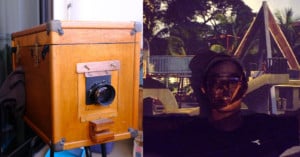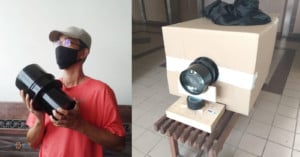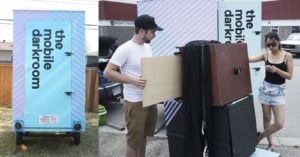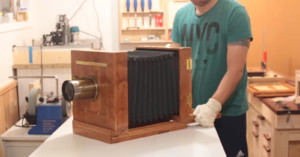
How I Made a 3D-Printed Film Movie Camera
A couple of years ago I have been occasionally shooting 35mm films with point-and-shoot still cameras while also having the desire to shoot motion picture films.

A couple of years ago I have been occasionally shooting 35mm films with point-and-shoot still cameras while also having the desire to shoot motion picture films.

It was Sunday morning January 25th, 1998, and I was in The Associated Press’s trailer in the parking lot at Qualcomm Stadium, San Diego. Last-minute preparations were underway for coverage of Super Bowl XXXII between the Green Bay Packers and the Denver Broncos – Favre vs Elway. Perfect!

I recently began shooting with the new LomoGraflok 4×5 instant back from Lomography on my Chamonix 4×5 camera and found that I needed to use a spacer every time we compose a shot.

For a digital artist like me, getting those unique ideas for my images is one of the most important things. I see the ideas in my dreams, when I read a magazine, when I’m out for a walk, or pretty much anywhere. I have learned that ideas are everywhere if you just allow yourself to see them.

Recently I bought a film camera from the 1970s, the Canon A-1. Considering that the camera is almost three times older than me, it was no surprise that there are a few issues with it.

I have been shooting 4x5 color transparencies or commonly known as color slide film for many years but the best that I could enjoy them was to put them on the light table and viewing them through a loupe. Unlike my 35mm and 120 slides, I have never seen them projected big simply it is not easy to locate a 4×5 slide projector.

Back in April, the Mars Perseverance rover shared a selfie that included the Ingenuity helicopter drone on the surface of the Red Planet. The space agency has now shared a video and detailed explanation of how that photo was taken, including the fact it is made up of 62 individual images.

A few years ago I built an ultra-large-format (ULF) camera that is 24 inches by 24 inches. While it was a pretty huge camera, it was a simple build it was just two square standards, one for the front and one from the back that were connected by a big bellow.

Artist Rudy Willingham created a clever stop motion video of NBA superstar LeBron James dunking. Frames of the dunk were printed, carefully cut, and then photographed while being held in front of a real-world location.

The Seoul gallery Blackmarket recently created a blacklight print of a photo by Seoul-based cyberpunk photographer Noe Alonzo. This 3-minute behind-the-scenes video shows how the print is made using screenprinting.

Two years ago in September, I was traveling in Kuusamo, Finland, and I had the opportunity to go see and photograph wild bears. We left our cars and started walking to the bear-watching hut with a small group. I felt nervous and it felt like a long walk in the woods, hearing all the little noises around us.

As a digital artist, I create images that are optical illusions, interesting concepts, and fantasy worlds. For this, I have to have tools to achieve my visions and this is where my retouching background comes into play.

Last month, Fujifilm announced the GFX 100, a game-changing 102-megapixel medium format mirrorless camera. cinema5D has released a 2-part documentary that gives us a behind-the-scenes look at how this monster of a camera came to be.

DxOMark is known for its lab tests of camera quality that are widely used by brands in marketing. To standardize its selfie camera tests to ensure repeatability, DxOMark has created a custom realistic mannequin to serve as a selfie subject.

In the "Olden Days," professional science was still in its infancy. People who trained in science and practiced science were using every ounce of creativity and imagination at their disposal to discover the nature of the world. They were scrappy and inventive. In this article, I will outline a modern replication of the experiment that produced the first color photograph ever made.

MAYA is a darkroom timer project that was born out of necessity when my old darkroom timer had started to malfunction. It has become a pretty successful crowdfunding campaign so far, exceeding 300% of its initial goal with a few days left to go.

Apple recently released a new series of ads for the iPad Pro that shows how the tablet computer opens the doors to new ways of doing things. What's neat is that Apple is "eating its own dog food": as the 2-minute behind-the-scenes video above reveals, the ads were shot, edited, animated, designed, and composed entirely on the iPad Pro.

Swedish photographer and retoucher Erik Johansson has created a new conceptual photo titled "Daybreaker," which shows the man in charge of controlling the transitions between day and night. Johansson is also sharing a behind-the-scenes look at how he put both day and night into one photo.

I’m not an environmental activist. I’m more or less a regular dude who hates taking out biowaste, still drives a diesel because it's cheaper, and recycles plastic because my wife tells me to. I enjoy our Finnish lake views, clean air, and peaceful sunsets, but rarely thought about losing them... until recently.

Sony has been receiving attention and praise in recent years for the quality of its sensors and the fact that it produces sensors for other heavyweight camera companies, including Nikon. But even though some of Nikon's CMOS sensors may be manufactured in Sony factories, Nikon actually spends a considerable amount of resources designing those high-end sensors.

Back in 2010, Canon was challenged by German wildlife filmmaker Ivo Norenberg create an extreme, "impossible" lens. Canon accepted the challenge, and this 7-minute video is the fascinating story of how the $70,000 Canon CINE-SERVO 50-1000mm T5.0-8.9 EF-mount cinema lens came to be.

A few years ago, I flew out to Ecuador to create a high-resolution image of the capital city of Quito. The final image turned out to be 16 gigapixels in size and at a printed size of over 25 meters (~82 feet), it allows people see jaw-dropping detail even when viewed from a few inches away.

In December 2015, Shane Arsenault and I had started talking about a joint photography project with the purpose of using his 16”x20” Bellows Camera on a larger scale, which would give us the freedom to work outside a conventional studio space.

There are fewer than 1,000 wet plate collodion artists practicing around the world, and as far as I know, I am the only one in the state of North Dakota. 5 years ago, I didn't own a camera and knew nothing about photography. I saw a wet plate online and I was immediately drawn to it, and thus my journey began.

Erik Johansson is a Swedish photographer who creates surreal scenes with his camera and Photoshop. His latest work is titled All Above the Sky. It shows a man climbing a ladder and poking his head above the sky, only to find himself looking up out of the waters nearby. Above is a 1-minute behind-the-scenes video that shows how it was created.

Photographer Dieter Schneider started building cameras about five years ago, and last year he fashioned a 4x5 camera using a CNC Machine. This year he took things to yet another level, creating an 8x10 large format camera entirely by hand without using computer-aided machinery. You can watch the entire build process in the 35-minute video above.

Photographer and visual artist Antti Karppinen has been reimagining photos using Photoshop for over 23 years now. Here's a before-and-after look at how Karppinen is able to take plain portraits (shot in studios, garages, and outdoors) and turn them into dreamlike images.

Gigapixel photos and lightning photos are generally created two different ways. One requires a mosaic of photos stitched together, and the other is usually a wide-angle view that's exposed at the moment of a lightning strike. That's what makes photographer Dan Piech's image "The Hand of Zeus" so amazing: it's a 5.449-gigapixel photo of a lightning strike in New York City.

Photo artist Erik Johansson was commissioned by Clinea, a Swiss company leading in the field of psychiatry and psychotherapy, to create something a little different. Johansson shot the images in Prague and Austria this year, creating beautiful photo manipulations that capture the essence of such a company.

Plenty of photographers these days try their hands at making their own cameras, but Swedish photographer, inventor, and camera maker Mats Wernersson recently did something a little more unusual: he made his own 90mm f/2.8 lens from scratch.